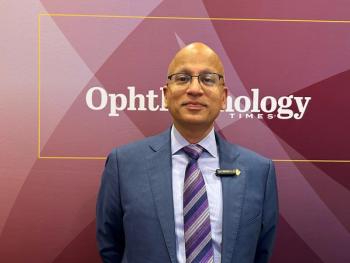
(AAO) Intravitreal anti-VEGF injections for exudative RAM offer an alternative to laser
At AAO 2020, Fernando Arevalo, MD, PhD, details the use of anti-VEGF therapy for the treatment of retinal arteriolar macroaneurysms that are near the fovea.
Reviewed by J. Fernando Arevalo, MD, PhD
Anti-vascular endothelial growth factor therapy (VEGF) performs well for treating retinal arteriolar macroaneurysms (RAM) that are near the fovea including the optic disc and does not cause branch retinal artery occlusion or rupture the RAM as can occur with direct laser photocoagulation, according to J. Fernando Arevalo, MD, PhD., reported.
Dr. Arevalo highlighted the treatment during a presentation at the American Academy of Ophthalmology’s virtual 2020 annual meeting.
He is the Edmund F. and Virginia B. Ball professor and chairman of ophthalmology at Johns Hopkins Bayview Medical Center, Wilmer Eye Institute, Johns Hopkins University, Baltimore, MD.
RAM are fusiform dilatations of the arteriolar system that are characterized by thickening of the arterial walls, Dr. Arevalo explained and pointed that that most of these lesions involute spontaneously but if they do not do so or do regress late, irreversible vision loss is possible from persistent cystoid macular edema, hard exudates, or intraretinal hemorrhages.
Dr. Arevalo and colleagues conducted a retrospective international multicenter study with the hopes of pinpointing the risks and benefits of anti-VEGF therapy for treating RAM and associated visual loss.
“We found that in 32 eyes of 32 patients treated with a mean of 2.7 anti-VEGF injections over a mean of 16.6 months the baseline vision improved over time from 0.97 logarithm of the minimum angle of resolution (logMAR) to 0.53 at 3 months,” he reported.
The concurrent central macular thickness (CMT) improved from the baseline 477 μmmicrons to 305 at 3 months. The mean RAM size was 450 μmmicrons and the mean distance to the fovea was 2,691 μmmicrons.
Ranibizumab (Lucentis, Genentech Inc.) was used to treat 14 patients and bevacizumab (Avastin, Genentech Inc.) in 16 patients. In 2 patients, aflibercept (Eylea, Regeneron Pharmaceuticals) was used in conjunction with bevacizumab in 1 patient and with both ranibizumab and bevacizumab in 1 patient.
One injection was administered in 13 eyes, the rest of the eyes required multiple injections ranging in number from 2 to 13.
Dr. Arevalo reported that the baseline best-corrected VA (BCVA) was significantly (P = 0.02) correlated with RAM size and the distance to the macula. The CMT decreased in size (P <0.001) by 131, 180, and 211 microns at 1, 2, and 3 months, respectively.
The BCVA improved (P = 0.005) by 0.47 and 0.38 logMAR, respectively, at 2 and 3 months post-injection. Finally, the response to anti-VEGF therapy was correlated with the RAM size (P =0.04) and the distance to the macula (P = 0.009).
In a representative patient, Dr. Arevalo showed the substantial benefit of 1 anti-VEGF injection 3 months later with reduction of exudates and at 9 months normalization of the foveal contour and improved vision.
Based on these results, Dr. Arevalo said the investigators concluded that anti-VEGF therapies improves the VA and decreases the macular edema via their vasoconstrictive effect and a stabilizing effect on the blood retinal barrier while the RAM undergo progressive fibrosis and closure.
In addition, the close proximity of the RAM to the fovea favors anti-VEGF treatment because there are no locally destructive side effects.
The resolution of perianeurysmal exudates or hemorrhages and gradual obliteration of the RAM seem to occur rapidly with anti-VEGF therapy by avoiding retinal damage from laser photocoagulation, Dr. Arevalo concluded.
---
J. Fernando Arevalo, MD, PhD
E: [email protected]
Dr. Arevalo has no financial interest in this subject matter. Intravitreal bevacizumab, ranibizumab, and aflibercept were used off-label in this study.
Newsletter
Don’t miss out—get Ophthalmology Times updates on the latest clinical advancements and expert interviews, straight to your inbox.



















































.png)


